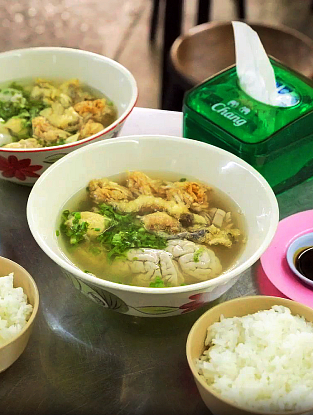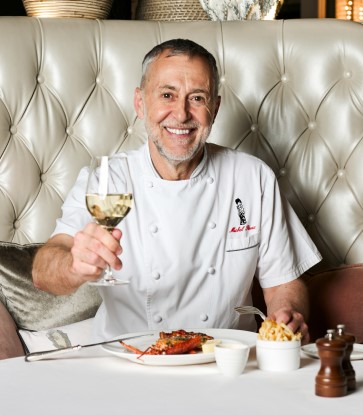The chef, Thierry Drapeau, who had achieved two MICHELIN Stars for nine consecutive years in his native France, couldn’t have picked a worse time to start a new venture in Thailand.
The 2022 MICHELIN-listed restaurant, Signature, opened just before the outbreak of COVID-19. The flow of international tourists dried up, and increasing lockdown restrictions throttled the hospitality industry. In the midst of all this, Chef Drapeau had to find a way to adapt his delicate, floral cuisine to local taste preferences more familiar with intense spices.
Two years on, Signature stands out in Bangkok’s diverse gastronomic scene for embracing nature's gifts, its eye-catching plate presentations, and a contemporary dining room with panoramic views of the city’s skyline.

On first entering, the L-shaped restaurant feels a little disorientating. Adorned in mid-20th century art-deco designs, complete with a grand piano, it felt like we had entered a second hotel lobby.
The arrangement of chairs around small tables, lush carpets, and velvet textiles, in fact, resembles the layout of a members’ lounge or gentlemen's club. You half expect to see wafts of cigar smoke accumulating around the macaron-shaped ceiling lights.
The first assurance we were in the right place, however, was the floor-to-ceiling wine cabinet behind the piano. Soon, we were welcomed by one of the restaurant's graceful waitresses wearing an elegant dress. No traditional uniform – a tight black top with a billowing floral designed skirt. The wait staff are a beautiful, graceful cast in this theatre of culinary exhibits.
We followed her as she glided flawlessly as she led us to one of the low tables for a welcome drink. Moments later, she reappeared, effortlessly presenting our amuse-bouche – a dioramic display of delicate flowers and canapes on a heavy wooden log base.

One ensemble comprised three carrot cones, each filled with carrot mouse and a topping of herring caviar. The delicate cones sat in tiny holes bored into a large carrot that lay in a bed of greenery. This was a stylish, light opener and a sign of things to come.
We were led to our dining table at the far end of the lounge beside a closed velvet curtain where we would settle into the tasting menu.
One early dish that stood out was the toothfish fillet served with a caramelised onion emulsion, Jerusalem artichoke jelly, and an onion foam. Here was evidence of an artist at work: a subtle blend of flavours and a melange of colour heightened with bright red flashes of begonia petals.
Having sampled a few magical hors d’oeuvres, a metallic clang rang out from behind the curtain which drew back to reveal the wizard behind the creations. Accompanied by his kitchen staff, the troupe took a bow, as the performance had begun.
Embracing nature in signature creations
Growing up in the picturesque Loire Valley, France, all the ingredients were there to feed Drapeau’s passion for food, nature, and artistry.
Sunday dinners were more than just a meal to be shared together as a family. They were the main event of the day. Drapeau would visit the local markets with his father to source fresh meats, fish, vegetables, herbs, and artisanal cheeses and wines. Back in the kitchen, Drapeau senior employed traditional slow cooking methods, the foundation of French home cooking.

One day, when Drapeau was 16 years old, his parents were too busy to prepare the customary Sunday dinner. His mother called him at home on the rotary dial phone, a bit of old technology that seems to have faded into the past. Most likely cradling the receiver between his ear and shoulder, he dutifully followed her instructions, filling pans, boiling water, and adding salt. A little bit of this, and a little bit of that.
The pasta itself may have been a simple dish – a common first attempt for many French children – but Drapeau was particularly moved by the idea of presentation and relished the opportunity to provide for others. Le plaisir de faire plaisir (the pleasure of making pleasure).
Within a matter of months, he applied and was accepted for an internship in a restaurant.
He developed a keen eye for detail and fastidious control over his environment, which are on display in the presentation of his kitchen and dining area. When the curtain pulls back, guests can see the chef in his element. Never resting, he is constantly moving, micro-managing the details, arranging hand-crafted presentations, and even slicing the sourdough.
His kitchen garden grows fresh, organic seasonal flowers and herbs, a fond reminder of helping his grandparents with their vegetable patch when he was little.

Along the wall’s length, an open refrigerator presents ingredients in wooden crates and baskets, much like the grocer’s organic section. And there’s a large mirror in one corner cleverly angled so he can keep a watchful eye over the kitchen prep area.
“The kitchen is organised based on my mindset,” Drapeau told us through an interpreter. “It’s necessary so I can see everything that’s happening in the room. And it’s really important that when the customer is here, they feel like they’re with us in the kitchen. Once the curtain is drawn, the spectacle begins,” he said with aplomb.
Inspired by culinary giants like Paul Bocuse and Joel Robuchon, a perfectionist and rigorous in his technique and style, Drapeau has established his own field of expertise and inspired many copycats in the art of floral cuisine.
“My cooking style is to take raw local products from farmers or producers and to tell a story – not only of the ingredients, but of the people behind them. I then add herbs and flowers to the dish to enhance the experience,” he said.
Drapeau described using flowers like having a good wine pairing. Many chefs use flowers, but more for aesthetics, without realising their true potential. For him, it’s about total control over the balance of flavours. He plays with the different flowers. Some have a peppery flavour. Others add an acidity. Marigold, he explained, has an orange aroma.
“The first time I came across flowers [in cooking], I was working in Paris at a MICHELIN-Starred restaurant,” the Frenchman recalled. “The chef told me the flowers weren’t just simply there to decorate a dish… but to balance the taste of a dish. I was hooked.”

Treasures of the east and west
In 2004, after winning his first Star, the French chef visited Vietnam for a culinary festival to showcase his cuisine. This was the start of his love affair with the region, the people, and the abundance of products. Soon enough, he visited Thailand where he met the future management and owners of Signature. The rest, as they say, was history.He doesn’t like to focus on the differences between Europe and Asia. Instead, he prefers to celebrate the things we share. “The seeds in France are the same as the seeds in Thailand,” he said. “It’s why we can find exactly the same flowers here.”
Drapeau’s subtle art form asks the diner to pause and think about the attentive care that goes into his craft and his use of ingredients. He doesn’t use much butter but prefers to use a product’s juice or essence to enhance flavours.
The fennel used in a dish called le bocage, for example, had been marinated overnight with coriander seeds, dill, and starched fennel seeds and then steamed for three hours. Finally, it’s served with Normandie scallops and anise butter, topped with a rice cracker, capers, and a pink dianthus flower.

The culinary horticulturist has also learned some new cooking techniques while living here. It may sound obvious to anyone who knows Thai food, but steaming rice in bamboo isn’t something that’s done in France. Drapeau feels the Thai techniques for frying food are also interesting. When one of his cooks showed him a different approach to frying a herb, they discovered together how they could use it in a recipe.
And these days, he uses a little bit more chilli to adapt dishes to local palates. The blue lobster from Brittany is lightly flavoured with oxalis flowers and served with a Thai-inspired herbal sauce, celery, and lightly pickled cucumber.
One dish not on the tasting menu is the Duck Wellington. Guests have to request it in advance. And when it arrived, two hours into our meal, we knew we’d made the right decision to hold off on the delicious range of breads. The canard challandais is a unique duck with a distinguished red and flavoursome meat. Served with a bourguignon sauce in a puffed pastry and a pink cosmos flower, it’s a satisfying meal on its own.
Then when a large chocolate egg arrived, accompanied with another garden display of sweets and treats, the tasting menu had us defeated. The egg was a smashing end to the performance, literally. Put on a white velvet glove, pick up the egg, and send it crashing down to the table. But as a second trove of dark chocolates, liquorice, and flowers tumbled out, we all looked at each other. Ca suffit! The oeuf was enough.
Hero image and other images: © Anuwat Senivansa Na Ayudhya / MICHELIN Guide Thailand







%20-%20Aman%20Nai%20Lert.jpg)











